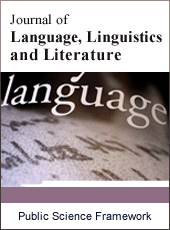Journal of Language, Linguistics and Literature
Articles Information
Journal of Language, Linguistics and Literature, Vol.1, No.2, Apr. 2015, Pub. Date: Apr. 8, 2015
Death and the Paradox of Rebirth in Esiaba Irobi’s Theatre: The Fronded Circle as Paradigm
Pages: 24-29 Views: 7422 Downloads: 2262
[01]
Samuel O. Chukwu-Okoronkwo, Department of Mass Communication, Abia State University, Uturu, Nigeria.
Despite the intense feeling of aversion which the mere portrait of death perhaps invokes on most living, the truism that death is a necessary end remains, nevertheless, immutable. Irobi was never pretentious about his understanding of this timeless truth. Through the aesthetics of his art he had always reinforced his belief in the ineluctable link between life and death and also drawn his audiences’ attention and consciousness to the grim reality of this seeming fatalistic phenomenon. Beyond mere cessation of life, however, Irobi’s portrait of death as a necessary end in his theatre reaches a transcendental dimension. This transcendence is realized in The Fronded Circle in the manner in which the tragic atmosphere that dominates the play from the opening scene, and culminates in a lethal ritual transition, is eventually mitigated with the birth of a new male child, in whom the future is symbolically embodied, thus evincing Irobi’s conscious exploration of the ritual performance tradition as a process of regeneration of society as highlighted in this study. The paper therefore reinforces Irobi’s indisputable belief in the importance of ritual as an integral part of the African theatre.
Death, Ritual Performance Tradition, Society, Societal Regeneration, African Theatre
[01]
Azuonye, N. (Magazine Monthly, Feb. 2003). “My e-Conversation with Esiaba Irobi”. Accessed June 15, 2012; retrieved from http://www.sentinelpoetry.org.uk/magazine0203/page42.html
[02]
Eze, N. O. (2010). “Magic and the Dramaturgy of Esiaba Irobi: A Study of The Fronded Circle”. Paper presented at 1st Global Conference, Inter-Disciplinary.Net, from Monday 15th – Wednesday 17th March, in Salzburg, Austria.
[03]
Irobi, E. (1999). The Fronded Circle. Enugu; ABIC Publishers.
[04]
Diala, I. (Oct. 17, 2010). “Esiaba Irobi ( 1960-2010) … the journey to Cemetery Road”. Accessed June 14, 2012; retrieved from http://www.vanguardngr.com/2010/10/esiaba-irobi-1960-2010-the-journey-to-cemetery-road/
[05]
Diala, I. (2005). “Ritual and Mythological Recuperation in the Drama of Esiaba Irobi”. In Research in African Literatures, Vol. 36, No. 4 (Winter): 87-114.
[06]
Morosetti, Tiziana. “The sow that repeatedly devours her own piglets: the villain on the Nigerian stage”. Accessed June 24, 2012; retrieved from http://www.inter-disciplinary.net/wp- content/uploads/2010/08/morosettipaper.pdf
[07]
Ewuzie, Alvan “Esiaba Irobi: The Season of death”, NBF, Thursday, May 13, 2010; retrieved from http://www.nigerianbestforum.com/generaltopics/?p=44063
[08]
Byok, Ira M. D. (2002). “The Meaning and Value of Death” Journal of Palliative Medicine, Volume 5, Number 2: 279 - 288
[09]
Grof, Stanislav. “The Experience of Death and Dying: Psychological, Philosophical and Spiritual Aspects” In Maps Bulettin. Volume xx number 1) 9 – 13. Accessed June 26, 2012; retrieved from www.maps.org/news-letters/v20n1/v20n1-9to13.pdf
[10]
Okeke, T. J. (2011). “Scenic Design as Paradigm for Sustainable Development: A Reading of Esiaba Irobi’s The Fronded Circle in Performance”. In The Humanities and Sustainable Development, (eds.) A. B. C. Chiegboka, T. C. Utoh-Ezeajugh, and M. S. Ogene. Nimo: Rex Charles & Patrick Ltd.: 782 – 787.
[11]
Nwankwo, I. E. (2005). “The Place of Women in Esiaba Irobi’s Theatre”. (Master’s Dissertation) University of Ibadan.

ISSN Print: 2381-7054
ISSN Online: 2381-7062
Current Issue:
Vol. 6, Issue 1, March Submit a Manuscript Join Editorial Board Join Reviewer Team
ISSN Online: 2381-7062
Current Issue:
Vol. 6, Issue 1, March Submit a Manuscript Join Editorial Board Join Reviewer Team
| About This Journal |
| All Issues |
| Open Access |
| Indexing |
| Payment Information |
| Author Guidelines |
| Review Process |
| Publication Ethics |
| Editorial Board |
| Peer Reviewers |


